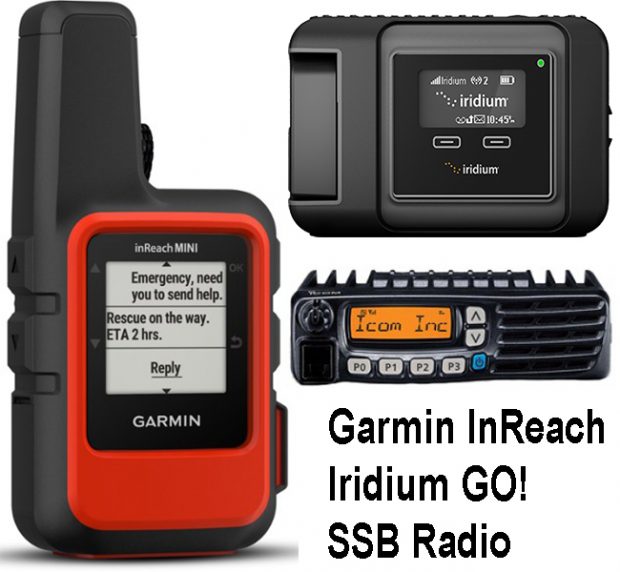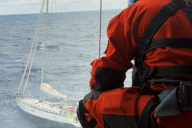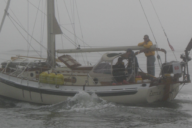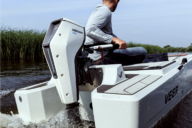Communications for offshore sailors has improved dramatically in the last two decades so it is now possible to sail across oceans without losing email, phone and text service and even an internet connection. But where does that leave the venerable HF radios of the good old days? We asked our readers and here are their excellent and thoughtful comments. GD
Hi George,
We have found Iridium GO! and InReach to be a simple and reliable combination for offshore voyaging. The performance of the GO! was dramatically enhanced by adding an external antenna and a base bracket at the nav station. The InReach was reliable and robust from the beginning. Great to have the redundancy.
Best,
Tom Babbitt
S/V Bravo
Hi George,
At this stage of communication development for smaller sailboats and power vessels (ones that for whatever reason can’t have everything) I would argue that SSB (Ham and marine SSB) and sat-comm serve different, overlapping for sure, but different functions.
For safety, sat-comms can’t be beat: you usually have immediate comm with any phone number in the world and you can take a handset with you on a life raft.
For fostering the feeling of community among those of us who choose to wander widely on small boats, SSB can’t be beat. It is an inexpensive way to talk over wide ranges and participate in the nets that link cruisers together into a community. When language is not an issue, it is a great way to connect with locals (Ham mostly). It is also a party line, so information and involvement are always public in a way that promotes connections.
The above are unique and discrete abilities. Overlap occurs where both are capable of accessing weather communications (including weather faxes, Navtex, gribs, text, etc), routing advice, email, etc. After initial set-up costs, Ham comm is free, Sailmail is very modestly priced, while sat-comm can be very pricey or modest depending on your needs and/or discipline.
There is an unfortunate trend away from SSB as sat-comm comes into its own but also because SSB is mistakenly (my opinion) seen as very complicated and fussy.
The above is general for all cruisers: the more remote the cruising, the more sat-comm is preferable. We were completely dependent on sat-comm in Greenland, for example, where, after 15+ years of relying on SSB (Ham in the Med, Northern Europe and the Caribbean) I was completely foiled in making it useful at that latitude and with little night to foster an ionosphere bounce.
My best,
Dick Stevenson, s/v Alchemy
George,
I thought about this for some time. I like the concept of broadcast nets that are still widely used both VHF and HF. I read through many online articles and discussions regarding or comparing Marine SSB to Sat phones, and I have come to realize that there is too much downplaying (or bad mouthing) HF radios in justifying the recurring high subscription costs of Sat phones. If one has no issues in having a Sat phone, InReach, and/or an Iridium Go!, then it makes for good sense to install an SSB radio, too. Many folks note a high initial cost of an SSB setup, but they have unfairly inflated the estimated cost. The reality is that a DIY person can install great performing systems for a fraction of these quoted costs. Furthermore, one can install an extremely affordable and substantial system by going with an HF amateur radio and obtaining an amateur license.
Two years ago, I looked into amateur radio and what it would take to get licensed. I read a few online documents, took a few online practice exams, and took and passed the Tech and General Class exams in one sitting. I recently purchased an HF setup for my sailboat. The quality of HF radios are excellent these days and the costs are dropping faster than the screwdriver that has fallen overboard. A new Yaesu FT-891 HF radio goes for $550. Add a $200 auto tuner (SGC SG-239), $100 USB sound card interface (SignaLink USB), a $200 backstay insulator (Sta-Lok), and $100 worth of wire, cable, and copper foils, and you have powerful system that will send and receive HF emails plus a plethora of other digital modes. These costs are not guesses as that is what I paid.
I have nothing against Sat phones, and may eventually get an Iridium Go! to go along with my Delorme InReach Explorer. But in the meantime, I have no additional expense for my HF radio. Downloading GRIBs (and FastSeas weather routes) has become a new hobby along with a few other off-the-boat HAM radio projects.
Paul E.
S/V Johanna Rose
Fort Walton Beach, FL
George,
I am responding to your request for feedback on whether I would prefer HF radio or a satellite system for offshore communications. I did outfit a new-to-me boat three years ago, and I researched this issue extensively. I have experience with both systems that I will share. As part of my research, I went to several seminars on the benefits and costs of the various systems. Many of these seminars featured seasoned offshore cruisers, and these folks unanimously endorsed having an HF radio plus getting a HAM license. So, I went out to do the same. Since I hadn’t yet purchased a boat, I studied for and passed the HAM exam. This wasn’t too hard, but it did take some study time to prepare. Then I bought a boat that had an SSB radio already installed. The surveyor did try it out and was not able to receive anything but static. So, I invested quite a lot of time and money getting it working. This was particularly hard since I had no firsthand experience with these and it is almost impossible to find an expert who could come to our boat and help diagnose problems.
I ended up replacing the radio, antenna, and counterpoise before I could get it working. I added a Pactor modem, and I was now ready to use email and get GRIB files. I used it on a trip to the Caribbean, and I found it to be quite time consuming and unreliable. I literally spent hours sometimes trying to get a GRIB downloaded from the Winlink (free for a HAM) system. I then decided to try the Sailmail (not free) system instead. I found this to have much better connectivity, and I was generally able to get a reliable connection within 15 minutes or so. However, it still had very slow connection speeds (even with a Pactor 4). Frankly, I feel that I have given the SSB a fair trial, and I find that it is really a hobbyest system, and it is not a system that can be relied on for important offshore communication. At this point, the Iridium GO! had been on the market for a couple of years. I spoke to several owners of the GO!, and they were all very happy with it. I was planning on crossing the Atlantic, and I was worried about the connection capability of the SSB across these distances, so I decided to buy an Iridium GO! and an external antenna along with the PredictWind weather routing service. The GO! is working great. It is much more reliable with significantly faster connections than the SSB. The PredictWind application makes downloading and viewing a GRIB and routing files a lot simpler and less time consuming.
However, I found it had some short comings. At first, I tried to use the Iridium email, but this was only available through their phone/tablet app (not the PC). Then these apps stopped working for me and I was cut off from my email as they don’t even have a web interface that I could use. This took about a month to get fixed, which made me realize that the Iridium email cannot be relied on when offshore. However, Airmail – the PC application that works with the SSB and Sailmail also supports the
Iridium GO! (plus it has a web interface). The other great thing about Sailmail is that you can manage your shore-based email (Gmail, Yahoo,etc.) and download the text part of these if you want, which I understand that Ocens does as well. Now I am using Airmail/Sailmail instead of the Iridium mail. This gives me more email redundancy and management capability. The Iridium GO! also advertises phone and internet capabilities. The phone works in a pinch, however the significant lags in reception make these calls too awkward for anything but important business. Finally, I have tried to use its internet capability, but it is so clunky that I have never been able to complete a search. Instead, I have news headlines emailed to me each day in order to stay connected. So, if I were giving advice to a new boat owner, I would say to forget the HF radio. Your money would be much better invested by getting a satellite system. I wish I had heard this before investing the time and money in an HF/SSB radio system. Some people say that having an SSB radio is additional security since it is a one-to-many system and a mayday broadcast might be heard by neighboring vessels. That is not really realistic. First, there is not a single channel for emergencies (like VHF 16) so your calls may never be heard unless the other boat is on the same channel. The newer SSB radios do have a DSC feature that scans the various channels. However, when I talk to other SSB users, most of them do not leave their radios on nor use the DSC scan feature routinely. And, if they do hear a mayday, they may be too far away to help (due the long range capability of HF). You can register your Iridium GO! with global rescue services and know that someone will answer when you need it. These folks can then coordinate feasible rescue resources. I hope this answers your question and that stories like this make it to future cruisers who need to make decisions about how to spend their limited budget for offshore communications.
Ted Owens












